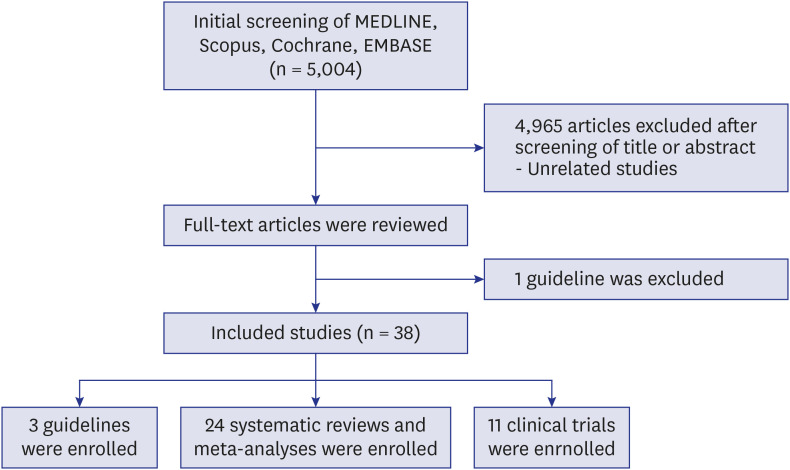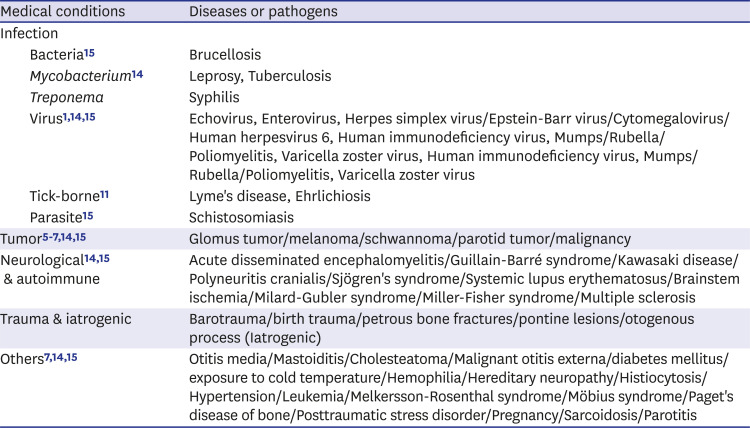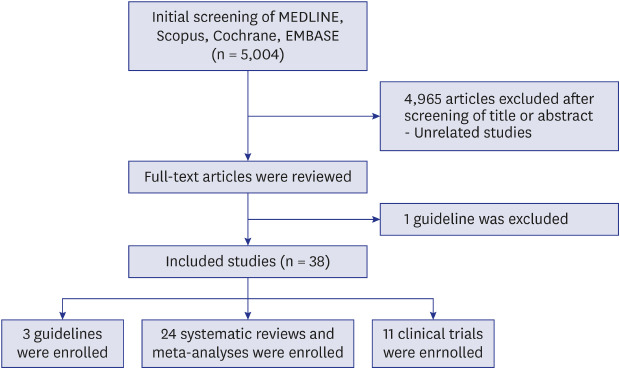1. Song K, Chang S, Lee J, Shin SA, Lee HY. Clinical characteristics of dizziness associated with acute peripheral facial palsy. J Audiol Otol. 2018; 22(3):148–153. PMID:
29656635.

2. Lee HY, Kim MG, Park DC, Park MS, Byun JY, Yeo SG. Zoster sine herpete causing facial palsy. Am J Otolaryngol. 2012; 33(5):565–571. PMID:
22445107.

3. Chang DS, Lee J, Shin SA, Lee HY. Characteristics of patients with acute peripheral facial palsy showing
Varicella zoster virus DNA in saliva. J Med Virol. 2018; 90(5):959–964. PMID:
29319192.
4. Rath B, Gidudu JF, Anyoti H, Bollweg B, Caubel P, Chen YH, et al. Facial nerve palsy including Bell's palsy: case definitions and guidelines for collection, analysis, and presentation of immunisation safety data. Vaccine. 2017; 35(15):1972–1983. PMID:
27235092.

5. Baugh RF, Basura GJ, Ishii LE, Schwartz SR, Drumheller CM, Burkholder R, et al. Clinical practice guideline: Bell's Palsy executive summary. Otolaryngol Head Neck Surg. 2013; 149(5):656–663. PMID:
24190889.
6. Gronseth GS, Paduga R. American Academy of Neurology. Evidence-based guideline update: steroids and antivirals for Bell palsy: report of the Guideline Development Subcommittee of the American Academy of Neurology. Neurology. 2012; 79(22):2209–2213. PMID:
23136264.

7. de Almeida JR, Guyatt GH, Sud S, Dorion J, Hill MD, Kolber MR, et al. Management of Bell palsy: clinical practice guideline. CMAJ. 2014; 186(12):917–922. PMID:
24934895.

8. Banks CA, Bhama PK, Park J, Hadlock CR, Hadlock TA. Clinician-graded electronic facial paralysis assessment: the eFACE. Plast Reconstr Surg. 2015; 136(2):223e–230e.
9. Fattah AY, Gurusinghe AD, Gavilan J, Hadlock TA, Marcus JR, Marres H, et al. Facial nerve grading instruments: systematic review of the literature and suggestion for uniformity. Plast Reconstr Surg. 2015; 135(2):569–579. PMID:
25357164.
10. Oya R, Takenaka Y, Imai T, Sato T, Oshima K, Ohta Y, et al. Neutrophil-to-lymphocyte ratio and platelet-to-lymphocyte ratio as prognostic hematologic markers of Bell's palsy: a meta-analysis. Otol Neurotol. 2019; 40(5):681–687. PMID:
31083100.

11. Gordillo-Pérez G, García-Juárez I, Solórzano-Santos F, Corrales-Zúñiga L, Muñoz-Hernández O, Torres-López J. Serological evidence of Borrelia burgdorferi infection in Mexican patients with facial palsy. Rev Invest Clin. 2017; 69(6):344–348. PMID:
29265112.

12. Remenschneider AK, Michalak S, Kozin ED, Barber S, De Venecia RK, Hadlock TA, et al. Is serial electroneuronography indicated following temporal bone trauma? Otol Neurotol. 2017; 38(4):572–576. PMID:
28114180.

13. Celik O, Eskiizmir G, Pabuscu Y, Ulkumen B, Toker GT. The role of facial canal diameter in the pathogenesis and grade of Bell's palsy: a study by high resolution computed tomography. Braz J Otorhinolaryngol. 2017; 83(3):261–268. PMID:
27217008.

14. Rath B, Linder T, Cornblath D, Hudson M, Fernandopulle R, Hartmann K, et al. All that palsies is not Bell's -the need to define Bell's palsy as an adverse event following immunization. Vaccine. 2007; 26(1):1–14. PMID:
18037542.
15. Zimmermann J, Jesse S, Kassubek J, Pinkhardt E, Ludolph AC. Differential diagnosis of peripheral facial nerve palsy: a retrospective clinical, MRI and CSF-based study. J Neurol. 2019; 266(10):2488–2494. PMID:
31250103.

16. Fujiwara T, Namekawa M, Kuriyama A, Tamaki H. High-dose corticosteroids for adult Bell's palsy: systematic review and meta-analysis. Otol Neurotol. 2019; 40(8):1101–1108. PMID:
31290805.

17. Uscategui T, Dorée C, Chamberlain IJ, Burton MJ. Antiviral therapy for Ramsay Hunt syndrome (herpes zoster oticus with facial palsy) in adults. Cochrane Database Syst Rev. 2008; (4):CD006851. PMID:
18843734.

18. Gagyor I, Madhok VB, Daly F, Somasundara D, Sullivan M, Gammie F, et al. Antiviral treatment for Bell's palsy (idiopathic facial paralysis). Cochrane Database Syst Rev. 2015; (11):CD001869.

19. Gagyor I, Madhok VB, Daly F, Sullivan F. Antiviral treatment for Bell's palsy (idiopathic facial paralysis). Cochrane Database Syst Rev. 2019; 9(9):CD001869. PMID:
31486071.

20. Lin RJ, Klein-Fedyshin M, Rosen CA. Nimodipine improves vocal fold and facial motion recovery after injury: a systematic review and meta-analysis. Laryngoscope. 2019; 129(4):943–951. PMID:
30450691.

21. Ordahan B, Karahan AY. Role of low-level laser therapy added to facial expression exercises in patients with idiopathic facial (Bell's) palsy. Lasers Med Sci. 2017; 32(4):931–936. PMID:
28337563.

22. Korlu S, Vayisoglu Y, Comelekoglu U, Aktas S, Arpaci RB, Yalin S, et al. Is mycophenolate mofetil an alternative agent to corticosteroids in traumatic nerve paralysis? J Craniofac Surg. 2014; 25(6):e510–3. PMID:
25347605.

23. Wambier SP, Garcia DM, Cruz AA, Messias A. Spontaneous blinking kinetics on paralytic lagophthalmos after lid load with gold weight or autogenous temporalis fascia sling. Curr Eye Res. 2016; 41(4):433–440. PMID:
26016510.

24. Ben Artsi E, Ullrich K, Brusasco L, Malhotra R. Long-term outcomes of upper eyelid loading with platinum segment chains for lagophthalmos: an adjustable approach. Am J Ophthalmol. 2020; 214:188–195. PMID:
31765627.

25. Gantz BJ, Rubinstein JT, Gidley P, Woodworth GG. Surgical management of Bell's palsy. Laryngoscope. 1999; 109(8):1177–1188. PMID:
10443817.

26. McAllister K, Walker D, Donnan PT, Swan I. Surgical interventions for the early management of Bell's palsy. Cochrane Database Syst Rev. 2013; (10):CD007468. PMID:
24132718.

27. Lee SY, Seong J, Kim YH. Clinical implication of facial nerve decompression in complete Bell's palsy: a systematic review and meta-analysis. Clin Exp Otorhinolaryngol. 2019; 12(4):348–359. PMID:
31487771.

28. Casazza GC, Schwartz SR, Gurgel RK. Systematic review of facial nerve outcomes after middle fossa decompression and transmastoid decompression for Bell's palsy with complete facial paralysis. Otol Neurotol. 2018; 39(10):1311–1318. PMID:
30239428.

29. Xie S, Wu X, Zhang Y, Xu Z, Yang T, Sun H. The timing of surgical treatment of traumatic facial paralysis: a systematic review. Acta Otolaryngol. 2016; 136(12):1197–1200. PMID:
27387924.

30. Li P, Qiu T, Qin C. Efficacy of acupuncture for Bell's palsy: a systematic review and meta-analysis of randomized controlled trials. PLoS One. 2015; 10(5):e0121880. PMID:
25974022.

31. Zhang R, Wu T, Wang R, Wang D, Liu Q. Compare the efficacy of acupuncture with drugs in the treatment of Bell's palsy: a systematic review and meta-analysis of RCTs. Medicine (Baltimore). 2019; 98(19):e15566. PMID:
31083225.
32. Teixeira LJ, Valbuza JS, Prado GF. Physical therapy for Bell's palsy (idiopathic facial paralysis). Cochrane Database Syst Rev. 2011; (12):CD006283. PMID:
22161401.

33. Natghian H, Fransén J, Rozen SM, Rodriguez-Lorenzo A. Qualitative and quantitative analysis of smile excursion in facial reanimation: a systematic review and meta-analysis of 1- versus 2-stage procedures. Plast Reconstr Surg Glob Open. 2017; 5(12):e1621. PMID:
29632792.
34. Roy M, Corkum JP, Shah PS, Borschel GH, Ho ES, Zuker RM, et al. Effectiveness and safety of the use of gracilis muscle for dynamic smile restoration in facial paralysis: a systematic review and meta-analysis. J Plast Reconstr Aesthet Surg. 2019; 72(8):1254–1264. PMID:
31204152.

35. Bos R, Reddy SG, Mommaerts MY. Lengthening temporalis myoplasty versus free muscle transfer with the gracilis flap for long-standing facial paralysis: a systematic review of outcomes. J Craniomaxillofac Surg. 2016; 44(8):940–951. PMID:
27364924.

36. Murphey AW, Clinkscales WB, Oyer SL. Masseteric nerve transfer for facial nerve paralysis: a systematic review and meta-analysis. JAMA Facial Plast Surg. 2018; 20(2):104–110. PMID:
29222560.
37. Li D, Kou Y, Huang S, Wang Z, Ning C, Zhao T. The harmonic scalpel versus electrocautery for parotidectomy: a meta-analysis. J Craniomaxillofac Surg. 2019; 47(6):915–921. PMID:
30954384.
38. Foresta E, Torroni A, Di Nardo F, de Waure C, Poscia A, Gasparini G, et al. Pleomorphic adenoma and benign parotid tumors: extracapsular dissection vs superficial parotidectomy--review of literature and meta-analysis. Oral Surg Oral Med Oral Pathol Oral Radiol. 2014; 117(6):663–676. PMID:
24767698.

39. Albergotti WG, Nguyen SA, Zenk J, Gillespie MB. Extracapsular dissection for benign parotid tumors: a meta-analysis. Laryngoscope. 2012; 122(9):1954–1960. PMID:
22753318.

40. Mashrah MA, Al-Dhohrah TA, Al-Zubeiry FA, Yan L, Al-Hamed FS, Zhao X, et al. Antegrade versus retrograde facial nerve dissection in benign parotid surgery: is there a difference in postoperative outcomes? A meta-analysis. PLoS One. 2018; 13(10):e0206028. PMID:
30339679.

41. Bylund N, Jensson D, Enghag S, Berg T, Marsk E, Hultcrantz M, et al. Synkinesis in Bell's palsy in a randomised controlled trial. Clin Otolaryngol. 2017; 42(3):673–680. PMID:
27882653.

42. Lapidus JB, Lu JC, Santosa KB, Yaeger LH, Stoll C, Colditz GA, et al. Too much or too little? A systematic review of postparetic synkinesis treatment. J Plast Reconstr Aesthet Surg. 2020; 73(3):443–452. PMID:
31786138.

43. Pourmomeny AA, Zadmehre H, Mirshamsi M, Mahmodi Z. Prevention of synkinesis by biofeedback therapy: a randomized clinical trial. Otol Neurotol. 2014; 35(4):739–742. PMID:
24317208.






 PDF
PDF Citation
Citation Print
Print




 XML Download
XML Download